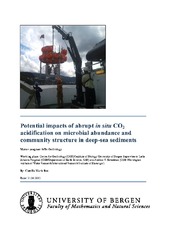| dc.description.abstract | Studying the environmental impacts of CO2 leakage is important to evaluate the risk of sub sea CO2 storage. If there were possibilities that small amounts of CO2 would leak out, what would the environmental impact be on the sedimentary microbial community? To be able to make this decision is important to know how to detect a leak and what to look for, a study on the microbial community can be an important biomarker for a CO2 leak. The presented in situ experiments are designed to mimic a CO2 leak from a CO2 storage site, and cope with the complications of working on the seafloor. This is made possible by using a benthic lander with incubation chambers that are able to close. By having two chambers placed on the seafloor, the sediments in one of them was exposed to CO2 acidified water of either 2 000 or 20 000 myatm pCO2, while the other was a parallel or control to compare any differences that occurred between the treatments after 40 hours experiment time. This study is a pin pointer in how the microbial community reacts when the pH is lowered because of CO2 acidification. Previous studies imply that a lowered ocean pH has a significant impact on the environment, and this study suggests that a decrease in one pH unit potentially could cause an increase in microbial activity are connected, which also leads to a increase in sediment oxygen consumption. Identification of the microbial community of the sediment using the 454 pyrosequencing method and by applying the mathematical tools Principal Component Analysis (PCA) in order to find the difference between a microbial community exposed to CO2 acidified water and microbial communities exposed to normal seawater. The PCA picked up a pattern in the relative abundance data indicating a depth gradient and also a difference between the sediments exposed to 20 000 myatm CO2 and the sediment that did not receive this treatment. | en_US |
